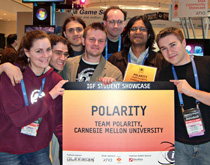It's easy to assume that the students sitting in beanbag chairs and playing the action-adventure videogame Legend of Zelda are goofing off. For the seven Carnegie Mellon Entertainment Technology Center graduate students, game time doesn't end with rescuing Princess Zelda. In ETC labs and on their home computers, they run through dozens more games. But they aren't just playing. They're examining background art, figuring out what kind of level systems are the most seamless, putting on headphones to listen to every game's background music and sound effects, noting which downloads are the easiest, identifying the most compatible software, determining what they, as players, have the most fun with.

Or, to put it another way, they are doing their homework. Howard Braham, Daniel Bryner, Przemyslaw Iwanowski, Stanley Rosenbaum, Gaurav Shrivastava, Samuel Spiro, and Allison Theus are a team trying to create an independent video game for their semester-long project.
As they get a feel for what's out there, they begin prototyping concepts of their own. They spend the next few weeks of the semester creating small demos, 30-second versions of game concepts. In one, players are honeybees dancing to direct their hives. In another, a spaceman with a magnetic suit may attract or repel himself against his environment based on his positive or negative charge.
Every few days the teammates come together and show each other their mini-games. Some are well received; some go right into the recycle bin. Eventually, they settle on a concept—the magnetic one—and begin expanding the 30-second demo into a full game they will call Polarity. They recruit their friends to play the game-in-progress. For the friends, it's a refreshing break from the rigors of studies. For the ETC students, it's more homework, observing their friends like psychologists—painstakingly jotting down what causes frustrations, triumphs, laughter.
The team regularly reviews the detailed observations, then storyboards more levels, adds more music, creates more background art. Every week, their mini-game gets bigger. By semester's end, Polarity is complete, unveiled, and sent out to independent gaming expos.
The game leads to any budding video-game designer's dream: a trip to Seattle and an all-access pass to the Penny Arcade Expo (PAX), the largest conference for video games in America. There, thousands of gamers stroll by, sit down, play Polarity. It ends up being selected as one of the "PAX 10," the top independent games of the year.
To play Polarity, visit www.polarityonline.com
—Bradley A. Porter (HS'08)



